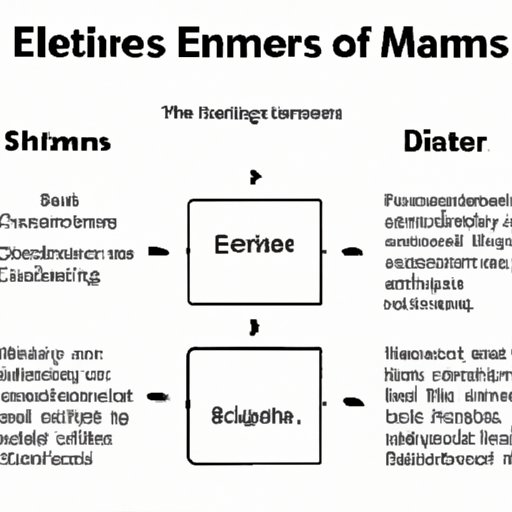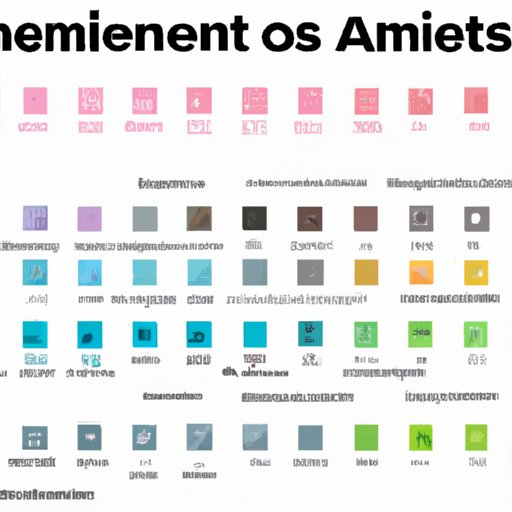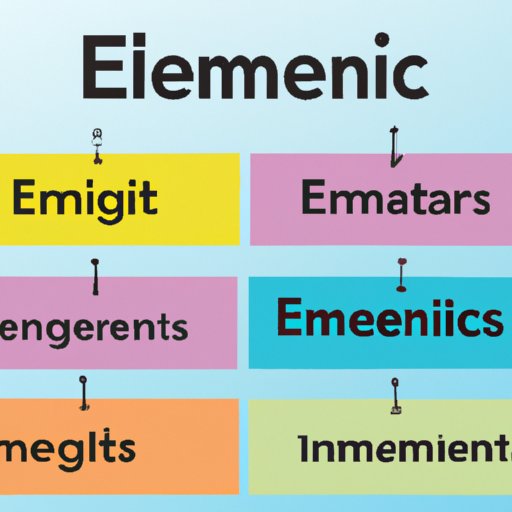Introduction
In science, elements are the building blocks of matter. They form the foundation of chemistry and are essential for life as we know it. Understanding the definition of an element in science is a key part of learning about chemistry and the world around us. In this article, we’ll explore what elements are and how they are defined in science.

Defining Elements: A Primer on the Building Blocks of Matter
To understand what elements are, it’s important to have a basic knowledge of chemistry. Chemistry is the study of matter, which is anything that has mass and occupies space. It is also the study of the changes that occur when matter interacts with other matter.
What is an Element?
An element is a substance composed of atoms with the same number of protons. Atoms are the smallest particles of an element that retain the properties of that element. Elements are made up of different combinations of protons, neutrons and electrons, and each element has its own unique atomic structure.
Properties of Elements
Elements have certain properties that can be used to distinguish them from one another. These include their boiling point, melting point, density, solubility, electrical conductivity and reactivity. Each element also has a unique set of chemical properties, such as how it reacts with other elements or compounds.
Exploring the Basics of Chemistry: What is an Element?
Chemists use symbols and names to identify elements. The most commonly used symbols are derived from the Latin names of the elements. For example, hydrogen is represented by the symbol “H,” while oxygen is represented by the symbol “O.”
Classification of Elements
Elements are classified into three main groups: metals, nonmetals, and metalloids. Metals are solid at room temperature, have high electrical and thermal conductivity, and are malleable and ductile. Nonmetals are poor conductors of electricity and heat, and are generally brittle and insoluble in water. Metalloids have properties of both metals and nonmetals.
Elemental Families
Elements can also be grouped according to their chemical properties. These groupings are called elemental families. Some examples of elemental families include alkali metals, transition metals, halogens, noble gases, and rare earth elements.
Breaking Down the Definition of Elements in Science
Atomic structure is a key factor in understanding the definition of an element in science. An atom consists of protons, neutrons and electrons. Protons and neutrons make up the nucleus of an atom, while electrons orbit the nucleus. The number of protons in an atom determines the element, since each element has a unique number of protons.
Chemical Bonds
Atoms interact with one another through chemical bonds. Chemical bonds involve the sharing or transfer of electrons between atoms. Depending on the type of bond formed, the atoms may attract or repel one another. This attraction or repulsion between atoms forms molecules, which are the building blocks of all matter.
Compounds and Mixtures
Compounds are substances made up of two or more elements chemically bonded together. Examples of compounds include water (H2O), carbon dioxide (CO2), and salt (NaCl). Mixtures, on the other hand, are combinations of two or more substances that are not chemically bonded together. Examples of mixtures include air, soil, and sand.

A Comprehensive Guide to Elements and What They Mean
Grouping elements can help further our understanding of the definition of an element in science. Elements can be grouped according to their physical and chemical properties, such as their boiling and melting points, density, solubility, electrical conductivity, and reactivity. Knowing the properties of elements can help us better understand their behavior and applications.

A Closer Look at the Definition of Elements in Science
The periodic table of elements is a useful tool for understanding the definition of an element in science. The periodic table is organized according to the atomic number of each element, which is the number of protons in an atom’s nucleus. Elements are arranged in columns, called groups, and rows, called periods. Knowing the position of an element on the periodic table can tell us a lot about its properties.
Metals, Nonmetals and Metalloids
Metals are elements that are good conductors of heat and electricity and are malleable and ductile. Nonmetals are elements that are poor conductors of heat and electricity and are brittle and insoluble in water. Metalloids are elements that have properties of both metals and nonmetals.
Radioactive Elements
Some elements are radioactive, meaning they emit radiation as they decay. Radioactive elements have unstable nuclei, which makes them highly reactive. Examples of radioactive elements include uranium, plutonium, and radon.
A Guide to the Definition and Properties of Elements
Valence electrons are electrons in the outermost energy level of an atom. Valence electrons determine how an atom interacts with other atoms, and thus how it behaves in a chemical reaction. Oxidation states refer to the number of electrons an atom has lost, gained, or shared in a reaction. Reactivity refers to how easily an element can form chemical bonds with other elements.
Elements 101: Understanding the Basics of Science
The history of elements dates back to ancient Greece, where philosophers such as Democritus theorized that matter was made up of indivisible particles. In 1869, Russian chemist Dmitri Mendeleev discovered the periodic table of elements, which helped scientists better understand the properties of elements. Today, elements are used in a wide variety of applications, from medicine to technology.
Conclusion
In conclusion, elements are the building blocks of matter and form the foundation of chemistry. Understanding the definition of an element in science is essential for learning about the world around us. Elements are identified by their symbols and names, and can be classified into different families based on their properties. They also have various applications in fields such as medicine, technology, and more. With this comprehensive guide, you now have a better understanding of the definition of elements in science.
(Note: Is this article not meeting your expectations? Do you have knowledge or insights to share? Unlock new opportunities and expand your reach by joining our authors team. Click Registration to join us and share your expertise with our readers.)
